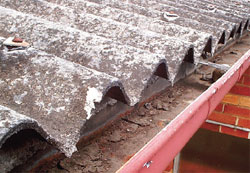By Dann Okoth
Kenya could be in the throes of massive asbestos pollution even as the killer material used in construction continues to gain a presence.
A walk through old Nairobi estates like Bahati, Kimathi and Ofafa Jericho reveals houses spotting asbestos roofs.
But the brown cement-like material is believed to be dangerous to human health.
Ageing roofs have exacerbated concerns of an outbreak of asbestos pollution.
There is a plant manufacturing the material in Mombasa.
"It is a ticking time-bomb," remarked Walter Ochoro, a lecturer at the University of Nairobi.
He says exposure to asbestos fibres lead to a condition called asbestosis, an inflammation of the lungs.
 |
Asbestos roof: The fibres are resistant to heat, fire, and chemicals and do not conduct electricity. Kenya could be in the throes of massive asbestos pollution even as the killer material used in construction continues to gain a presence. |
This, he says, could be more dangerous in children as their organs have not fully developed.
But legal loopholes that hinder governance of asbestos use, ignorance and a conspiracy of silence among Government officials including health and environmental professionals over the effects of the material is the most appalling development.
Panorama encountered officials, who were either ignorant or had reasons to avoid the issue altogether.
"I would rather not discuss the matter because I do not know much about it," remarked a lecturer at the department of Medicine at the University of Nairobi.
The use of asbestos was outlawed in the 1980s, although enforcement has been weak. It is not immediately clear how much asbestos had been used by that time.
In 2006, press reports quoted the Rift Valley Provincial Occupational Health and Safety Officer Emily Taruru, telling those who had removed asbestos from their roofs to bury the material.
Removal of asbestos roofing began after studies found out it caused lung cancer.
Won awards
Indeed American physician and scientist, Irving Selikoff, became famous for his campaign against the use of asbestos, he warned the spray used to fireproof parts of New York’s World Trade Centre (WTC) would lead to deaths of the workers who applied it. Dr Selikoff, who won awards for his research, had shown that asbestos caused cancer when it degraded.
The WTC, which was built between 1968 and 1972, had large amounts of asbestos spray to fireproof the building.
Asbestos abatement at the twin towers made the bulk of $800,000 (about Sh64 million) worth of repair work planned in 1999.
The building was brought down in a terrorist attack in 2001.
By then, it was not known if Dr Selikoff’s warning had come to pass. But some analysts said the attacks solved the asbestos problem.
In Kenya, however, communities still grapple with the problem of disposing of the potentially harmful material.
Even in newer estates like Donholm and Jacaranda in Nairobi’s eastlands, heaps of asbestos waste can be seen.
Cancer risk
Street children and garbage workers who sift through the material run the risk of getting cancer.
According to Prof Charles Omwandho of the University of Nairobi exposure leads to lead poisoning.
 The Standard Group Plc is a multi-media organization with investments in media
platforms spanning newspaper print operations, television, radio broadcasting,
digital and online services. The Standard Group is recognized as a leading
multi-media house in Kenya with a key influence in matters of national and
international interest.
The Standard Group Plc is a multi-media organization with investments in media
platforms spanning newspaper print operations, television, radio broadcasting,
digital and online services. The Standard Group is recognized as a leading
multi-media house in Kenya with a key influence in matters of national and
international interest.
 The Standard Group Plc is a multi-media organization with investments in media
platforms spanning newspaper print operations, television, radio broadcasting,
digital and online services. The Standard Group is recognized as a leading
multi-media house in Kenya with a key influence in matters of national and
international interest.
The Standard Group Plc is a multi-media organization with investments in media
platforms spanning newspaper print operations, television, radio broadcasting,
digital and online services. The Standard Group is recognized as a leading
multi-media house in Kenya with a key influence in matters of national and
international interest.










